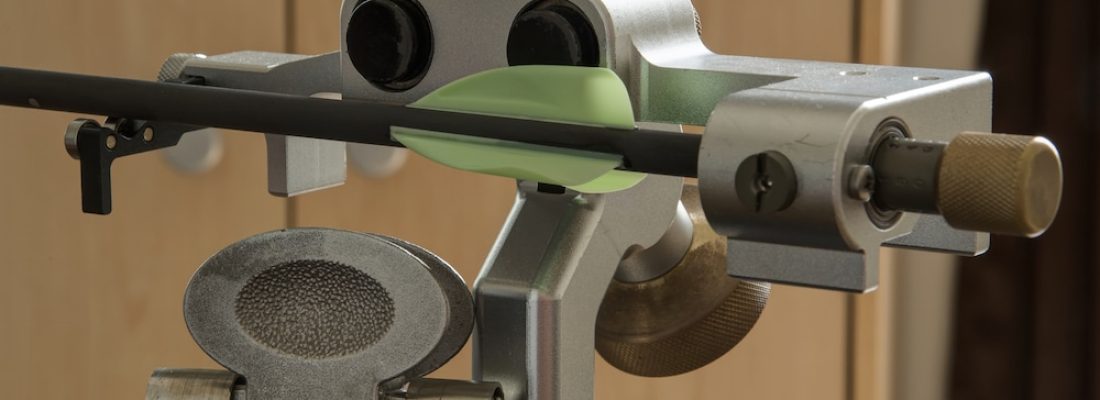No products in the cart.

365 Archery 3D Archery Targets
When folks enter a new industry, or even a new subsection of their industry, they usually dip their toe in by offering one or two

Blog / Product Reviews / Firenock Aerovane III – Advancement in Arrow Fletching Technology

When it comes to developing the most technically advanced products for the archery industry, it’s hard to beat the brilliant mind of Firenock’s Owner, Dorge Huang. Anyone that has had the opportunity to talk to Dorge in person at one of the many local hunting shows he attends, the ATA Show, or even over the phone knows he is adamant in redefining the limits of modern archery equipment. If improvements can be made to an existing product to squeeze out better performance, or if there simply isn’t a product on the market to solve the problem you didn’t even know you had, there is a good chance the idea has already been rattling around in Dorge’s brain.
In the spring of 2008, the original Aerovane was introduced in an effort to provide a much quieter, and more efficient arrow vane. Every other vane on the market at the time utilized drag (friction) as a way to develop rotation of the arrow. This typically required fletching the vanes at severe angles to produce enough drag on the arrow to induce rotation quicker, thereby stabilizing your broadhead-tipped arrow. With the concept of airfoil technology, less drag was induced on the vane which results in less velocity lost in flight and more kinetic energy being delivered downrange where it is needed. The lower drag also produces much quieter arrow flight. The rounded front (closely resembling an owls wing) and thickness of the Aerovane also helps to reduce noise as the typical vane will “flutter” while in flight as it has no rigidity.
After extensive testing of the original Aerovane concept/design, and after consulting with low-speed airfoil experts, the original Aerovane was refined into a newer/improved (and shorter overall length) Aerovane II shortly thereafter. If you want to read up more on the technical aspects of the Aerovane II, click here: Aerovane II Info Page.
The introduction of a precision fletching jig in 2010 (Aerovane Jig) allowed for further improvements to the Aerovane design. The most noticeable difference between the Aerovane II and Aerovane III is the winglet on the top of the Aerovane III. The addition of the winglet, and the addition of a 4th micro-texturing zone to the Aerovane III increased the crosswind stability and aerodynamic efficiency of the 3rd generation Aerovane over the Aerovane II. The overall height and weight of the Aerovane was also reduced between Aerovane II and Aerovane III providing more cable clearance and greater FOC (front of center).
One might ask, “If the Aerovane III has all these improvements over the Aerovane II, then why even consider using the Aerovane II?” Well this is where it gets a little tricky. Like any high performance “machine”, having finely tuned equipment is of the utmost importance. The broadhead you choose to put on the tip of your arrow can also affect the performance of the Aerovane III. We use and trust Grim Reaper expandable broadheads and have had great success with this combination in the past. Per Firenock, it is recommended that you fletch Aerovane III straight (0° offset) to gain optimum performance with arrows shooting over 280 ft/sec; It can be fletched up to a 1.5° offset for arrows shooting as slow as 150 ft/sec and still have excellent performance.
The Aerovane III weighs in at 5.18 grains, has an overall length of 1.967″, and an overall height of 0.39″. The Aerovane III is available in 10 colors, and is available by ordering direct from Firenock’s website here: Aerovane III 18 pc / 100 pc pack.
If for some reason you aren’t as comfortable with the tuning of your setup, or if you are shooting a whisker biscuit type rest, take a good look at upgrading your current fletching to the Aerovane II. You will notice a big difference in your arrow’s flight and broadhead control after switching from the older flimsy plastic vanes to the Aerovane II.
I have personally been using the Aerovane III vanes for the past 2 years and have had great success with them through turkey and whitetail season here in the Midwest. I’ve never been more confident in taking a shot at 50-60 yards in actual hunting conditions (and much further during practice sessions) than I have since making the switch to the Aerovane III. I’m looking forward to testing them in the wide open western terrain this fall as I chase after Elk for the first time this September.

When folks enter a new industry, or even a new subsection of their industry, they usually dip their toe in by offering one or two

Highlights of Greylight’s new releases for 2024 – the Daybreak Blind, Transformer Tower, and Nomad trailer.

With one of their coolest decoys to date, the NWTF floor was buzzing with talk of the new DSD Preening Hen decoy. It’s almost TOO
Don’t miss a thing! Subscribe below to keep informed on everything that’s happening with the folks at SELFILMED.com